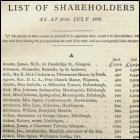City of Glasgow Bank
"This great social and commercial disaster - the result of utterly reckless and dishonest speculation on the part of the Glasgow Board of Directors - was made public late in the evening of the 1st of October [1878], by the resolution of the Directors to close their doors on the following morning. When the announcement appeared in the newspapers of Wednesday, October 2, the public was completely taken by surprise; and some days elapsed before it could be realised what a crushing blow had fallen on the unfortunate Shareholders, and on the credit of the country."
The City of Glasgow Bank was established in 1839 with 779 subscribers and a capital of £656,250. It catered particularly for small investors with branches opening in the evenings to receive deposits. Its head office was in Glasgow, in Virginia Street, from 1842 moving to Glassford Street in 1851 when the former premises were sold to the National Security Savings Bank.
The bank is infamous as the scene of Glasgow's greatest financial disaster of the Victorian era. In June 1878, the directors reported that there were now 133 branches of the bank and that business was booming with deposits of £8m and that a dividend of 12 per cent would be paid. All appeared well and so the City was devastated when on 2 October of the same year the newspapers reported that the directors had decided to close the bank.
The City of Glasgow Bank asked other banks for assistance but when they sent in an accountant it was discovered that the bank's affairs were beyond assistance. Huge loans had been made to borrowers on inadequate security; speculative investments had been made in land, sheep farms and wool in New Zealand and Australia in the hope of recovering losses that the bank had made investing in mining stocks and American railway bonds and shares. False reports had been made to the fiscal officers concerning the amount of gold held as security for notes issued, and as the need for greater mis-statement arose, the extent of the falsification increased.
The last balance sheet published before the closure was dated 5 June 1878, and indicated capital, reserves and undistributed profits totalling £1.6m. The accountants' examination, made immediately after the closing of the bank, three months later, revealed that the capital and reserves were in fact entirely wiped out, and that there was a deficiency of capital estimated at the astounding figure of £5.19m. The immediate arrest of the bank's directors was ordered.
The effect of the bank's failure on Glasgow business was immense. Hundreds of firms folded as a result and the 1200 shareholders and their families suffered greatly. Indeed, the City of Glasgow Bank failure emphasised the desirability of the Scottish banks to accept the principle of limited liability to protect stockholders and within a few years of the failure, the banks resolved mutually to become limited.
The City of Glasgow Bank failure resulted in greater publicity "than had ever previously fallen to the lot of any business establishment" and was seen as "an event which would long be remembered by thousands in Scotland as the saddest and darkest in their history". The directors were tried at the High Court in Edinburgh in January 1879 and all were found guilty. Robert Stronach and Lewis Potter, a director since 1858, were found guilty of fraud and each sentenced to 18 months imprisonment and the others to 8 months each.
Records relating to the collapse of the City of Glasgow Bank are to be found at the Scottish Business Archive, University of Glasgow.
Sources
Tyson, R E, 'Scottish Investment in American Railways: The Case of the City of Glasgow Bank, 1856-1881', Payne, P L (ed.), Studies in Scottish Business History (London, 1967).
Leo Rosenblum, 'The Failure of The City of Glasgow Bank', The Accounting Review, Vol. 8, No. 4 (December 1933), pp. 285-291.
Records of the City of Glasgow Bank, Glasgow, Scotland (GUAS Ref: GB 248 UGD 108).



